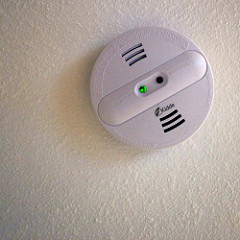
If a fire were to start in your cottage while you are sleeping, you could suffer smoke inhalation before you even know what is happening. The combination of toxic smoke and gasses will reduce oxygen levels in your cottage, making it extremely difficult to wake up and get out, or will make it impossible to wake up at all. It is essential to install and maintain working smoke alarms on every level of your cottage – and your home in the city – and outside of all sleeping areas. The speed of smoke production and flame spread in houses today could give you less than two minutes to wake up and get out of your cottage. Your ability to wake up quickly hinges on your smoke alarms operating smoothly. It's the law It is extremely important to install smoke alarms in your cottage – and your house in the city. In keeping with the law, you must install working smoke alarms on every level of your cottage and outside of all sleeping areas. (This may include your camp, cabin, RV, boat, trailer, etc.)
What’s the difference between a smoke alarm and a smoke detector?
A smoke alarm is an all-in-one, self-contained device including a detector and an alert system. The detector portion of the smoke alarm detects smoke, gas, and particles produced by a fire. The alert system activates an aud-inline-blockle or visual alarm. A smoke detector is a sensory device only and does not contain a built-in aud-inline-blockle alert system. A smoke detector senses smoke and sends a signal through a building's fire alarm system to an aud-inline-blockle device (bells, horns, strobes, sirens, etc.) Smoke detectors cannot alert people of fire unless they connect to a fire alarm system containing the aud-inline-blockle devices.
The technology
There are two kinds of technologies available regarding detection devices within smoke alarms. Most smoke alarms only contain one kind of detection. However, some contain both. Depending on the installation location and surroundings, one kind of technology may be more effective than the other.
Smoke alarms are designed to be operated by battery power or by alternating electrical current supply (110v). Some electrically-operated smoke alarms have a backup battery supply. You must change the batteries and ensure they are always charged to ensure the backup supply operates properly. When it’s time to replace a smoke alarm, make sure you replace it with an equivalent alarm. You cannot replace an electrically-supplied smoke alarm with a battery-powered smoke alarm. When you purchase a smoke alarm, make sure a standards organization, such as Underwriters Laboratories of Canada (ULC) or Underwriters Laboratories Incorporated (cUL), has listed it.
Nuisance alarms
As soon as you purchase a new smoke alarm, make sure you read and understand the manufacturer's instructions. The instructions contain many important details to help you safely operate and maintain the smoke alarm. Some smoke alarms require specific makes of batteries to operate. Others have multiple alerts that produce sound. And some have very specific cleaning instructions. If you don’t read the manufacturer's instructions, you won’t understand the meaning of important alert tones the smoke alarm may emit. In some situations, a smoke alarm may sound when there is no fire, which is called a false alarm. For example, a smoke alarm may sound near a bathroom door when someone has a shower that produces hot steam, or in the hallway leading to the kitchen when someone is cooking. Although each situation is different, there are many options to limit false alarms. You may wish to consult the manufacturer's instructions for advice on placing the smoke alarm in a more effective location. You may also purchase a smoke alarm that uses a different technology. For example, you could replace an ionization alarm with a photoelectric alarm. If you do make a switch, don’t replace an electrically-powered alarm with a battery-powered alarm or choose an alarm that provides a reduced level of protection.
Warning: False alarms cause complacency. If you experience frequent false alarms, consider your options and correct the problem as soon as possible.
Warning: If your smoke alarm goes off, never assume it’s a false alarm. Always identify any potential smoke sources and be sure a safe condition exists.
Test: Follow the manufacturer’s recommendations regarding the testing and replacement of a smoke alarm. However, generally speaking, you should replace a smoke alarm that’s older than ten years with a new smoke alarm. Test your smoke alarm regularly, which will help ensure your family is kept safe from smoke and fire. Testing your smoke alarm is quick and simple. Plan a time and date and designate a “home tester” within your family. Just push the “test” button, which is usually all it takes. Replace your batteries at least once each year. Most people replace their batteries when they adjust their clocks in the spring and the autumn. Smoke alarms connected to an electrical power source may also have a backup battery supply. You need to check the batteries and replace them when necessary.
Photo courtesy of Faruk Ateş No Alterations Made - Creative Commons